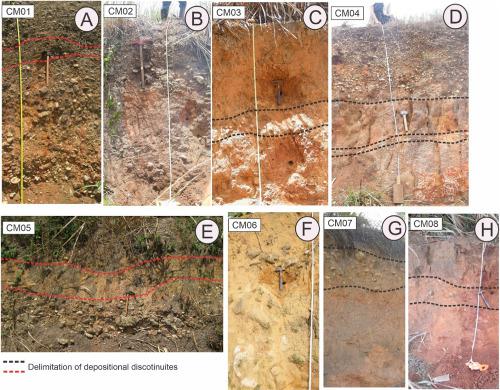当前位置:
X-MOL 学术
›
Earth Surf.Process. Land.
›
论文详情
Our official English website, www.x-mol.net, welcomes your
feedback! (Note: you will need to create a separate account there.)
Coupling of tectonic factors and precipitation variability as a driver of Late Quaternary aggradation in Northeast Brazil
Earth Surface Processes and Landforms ( IF 2.8 ) Pub Date : 2020-08-24 , DOI: 10.1002/esp.4982 Drielly Naamma Fonsêca 1 , Antonio Carlos Barros Corrêa 1 , Bruno Azevêdo Cavalcanti Tavares 2 , Daniel Rodrigues de Lira 3 , Ana Clara Magalhães de Barros 1 , Demétrio Silva Mützenberg 2
Earth Surface Processes and Landforms ( IF 2.8 ) Pub Date : 2020-08-24 , DOI: 10.1002/esp.4982 Drielly Naamma Fonsêca 1 , Antonio Carlos Barros Corrêa 1 , Bruno Azevêdo Cavalcanti Tavares 2 , Daniel Rodrigues de Lira 3 , Ana Clara Magalhães de Barros 1 , Demétrio Silva Mützenberg 2
Affiliation

|
The coupling between tectonic factors and climate processes is a key element in understanding landscape evolution. However, few studies address this issue in the context of unglaciated tropical areas in passive continental margins. Thus, this research aimed to understand the origins and evolution of the geomorphological landscape in the eastern sector of Northeast Brazil along the Late Quaternary, between the Last Interstadial (Marine Isotopic State 3) and the Upper Holocene. The morphostratigraphic approach, coupled with sedimentological analyses and optically stimulated luminescence dating of sediments, showed that the depositional record stored in the landscape ranges from at least 60 000 years BP until the Upper Holocene. Depositional intervals suggest that there were moments of climatic instability followed by moments of relative geomorphological quiescence. Such active moments coincide chronologically with Heinrich and Dansgaard‐Oeschger events, which are likely linked to changes in paleo‐pluviosity that might respond to the dismantling of elluvial covers and colluvial deposition in the area. Likewise, reworking of hillslope materials led to increased deposition in the fluvial realm. In addition, such deposits might have been affected by the neotectonic complexity of the area, responsible for the creation of non‐concatenated accommodation spaces, indicating a dynamics of uplifting and subsidence of blocks typical of passive margin taphrogenic environments. Therefore, the formative processes that led to the Late Quaternary deposition of sediments in a platform margin context reflect a coupling between tectonic and climatic factors. The former, driven by precipitation variability on a regional scale, triggered fluvial and high‐energy hillslope processes that resulted in ubiquitous valley floor and piedmont aggradation, whereas the latter led to the dismantling of local base levels, transforming depositional units into new denudational landforms subject to the current climate dynamics. © 2020 John Wiley & Sons, Ltd.
中文翻译:

构造因子与降水变化的耦合作用是巴西东北部第四纪晚期沉积的驱动力
构造因子与气候过程之间的耦合是理解景观演化的关键要素。但是,很少有研究在被动大陆边缘的无冰川热带地区的背景下解决这个问题。因此,本研究旨在了解巴西东北部东部第四纪晚期第四纪末期(海洋同位素3)和上全新世之间地貌景观的起源和演变。形态地层学方法,再结合沉积学分析和沉积物的光激发发光测年,表明在景观中存储的沉积记录范围从至少6万年BP到上新世。沉积时间间隔表明,存在气候不稳定的时刻,随后是相对地貌静止的时刻。这些活跃时刻按时间顺序与Heinrich和Dansgaard-Oeschger事件重合,这很可能与古坡度的变化有关,这可能与该地区冲积层的拆除和河流沉积有关。同样,对山坡材料进行返工导致河床区沉积增加。此外,此类沉积物可能已经受到该地区新构造复杂性的影响,从而造成了无级联的居住空间的产生,这表明了被动边缘成因环境中典型块体的抬升和沉降动态。因此,在平台边缘背景下导致沉积物第四纪晚期沉积的形成过程,反映了构造和气候因素之间的耦合。前者在区域范围内的降水变化的驱动下,触发了河流和高能的山坡过程,导致无处不在的谷底和山前积聚,而后者导致了当地基础水平的瓦解,将沉积单元转变为新的具剥蚀性的地形形式。适应当前的气候动态。©2020 John Wiley&Sons,Ltd. 后者导致了当地基础水平的拆除,在当前气候变化的作用下,将沉积单位转变为新的具剥蚀作用的地貌。©2020 John Wiley&Sons,Ltd. 后者导致了当地基础水平的拆除,在当前气候变化的作用下,将沉积单位转变为新的具剥蚀作用的地貌。©2020 John Wiley&Sons,Ltd.
更新日期:2020-08-24
中文翻译:

构造因子与降水变化的耦合作用是巴西东北部第四纪晚期沉积的驱动力
构造因子与气候过程之间的耦合是理解景观演化的关键要素。但是,很少有研究在被动大陆边缘的无冰川热带地区的背景下解决这个问题。因此,本研究旨在了解巴西东北部东部第四纪晚期第四纪末期(海洋同位素3)和上全新世之间地貌景观的起源和演变。形态地层学方法,再结合沉积学分析和沉积物的光激发发光测年,表明在景观中存储的沉积记录范围从至少6万年BP到上新世。沉积时间间隔表明,存在气候不稳定的时刻,随后是相对地貌静止的时刻。这些活跃时刻按时间顺序与Heinrich和Dansgaard-Oeschger事件重合,这很可能与古坡度的变化有关,这可能与该地区冲积层的拆除和河流沉积有关。同样,对山坡材料进行返工导致河床区沉积增加。此外,此类沉积物可能已经受到该地区新构造复杂性的影响,从而造成了无级联的居住空间的产生,这表明了被动边缘成因环境中典型块体的抬升和沉降动态。因此,在平台边缘背景下导致沉积物第四纪晚期沉积的形成过程,反映了构造和气候因素之间的耦合。前者在区域范围内的降水变化的驱动下,触发了河流和高能的山坡过程,导致无处不在的谷底和山前积聚,而后者导致了当地基础水平的瓦解,将沉积单元转变为新的具剥蚀性的地形形式。适应当前的气候动态。©2020 John Wiley&Sons,Ltd. 后者导致了当地基础水平的拆除,在当前气候变化的作用下,将沉积单位转变为新的具剥蚀作用的地貌。©2020 John Wiley&Sons,Ltd. 后者导致了当地基础水平的拆除,在当前气候变化的作用下,将沉积单位转变为新的具剥蚀作用的地貌。©2020 John Wiley&Sons,Ltd.











































 京公网安备 11010802027423号
京公网安备 11010802027423号